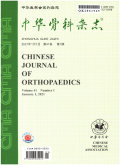椎基静脉孔与椎体内裂隙相通可能是后凸成形术骨水泥渗漏的危险因素
The connection between the basivertebral foramen and the intravertebral cleft could be a related factor of cement leakage after percutaneous kyphoplasty
摘要目的 通过对伴与不伴椎内裂隙征的椎体行经皮椎体后凸成形术(percutaneous kyphoplasty,PKP)后不同类型骨水泥渗漏的发生率的评估,探讨椎基静脉孔和椎内裂隙相通是否为骨水泥渗漏的危险因素.方法 回顾性分析2009年1月至2013年1月我科行PKP手术的224例患者的270个手术椎体术前与术后X线片、CT及MRI.所有病例依据是否存在椎体内裂隙分为裂隙组和骨小梁组.将骨水泥渗漏分为五型:通过骨皮质缺损进入椎旁软组织(A型),通过椎基静脉孔(B型),通过进针管道(C型),通过骨皮质缺损进入椎间盘区域(D型),以及通过椎旁静脉(E型).分别统计两组各类型的骨水泥渗漏的发生率并分析差异是否有统计学意义.结果 裂隙组72例,骨小梁组198例.B型骨水泥渗漏最为常见,占总手术椎体的15.5%(42例),其次为D型骨水泥渗漏(7.8%,21例).裂隙组B型骨水泥渗漏发生率为23.6%,高于骨小梁组的12.6%,且两者之间差异有统计学意义(P=0.028).其余各型骨水泥渗漏之间差异无统计学意义.结论 B型骨水泥渗漏在伴椎内裂隙征的椎体中更为常见,说明椎内裂隙征和椎基静脉孔之间存在通道.因此,在伴椎内裂隙征的椎体行PKP手术时,需特别小心避免骨水泥通过椎基静脉孔漏入椎管.
更多相关知识
abstractsObjective To assess incidence rate of different types of cement leakage in percutaneous kyphoplasty (PKP) with or without intravertebral clefts and to determine whether basivertebral foramen could be connected with intravertebral cleft.Methods 270 vertebrae in 224 consecutive patients who underwent percutaneous kyphoplasty for treatment of osteoporotic vertebral compression fractures were classified into two groups on preoperative radiographs,computed tomography scans,and/or magnetic resonance images of the treated levels:Cleft group with an intravertebral cleft in vertebral body and trabecular group without intravertebral clefts.On direct postoperative images,the patterns of cement leakage were classified as 5 types:through a cortical defect into paraspinal soft tissues (type A),through the basivertebral foramen (type B),via the needle channel (type C),through a cortical defect into the disc space (type D),via the paravertebral vein (type E).The incidence of different types of cement leakage between two groups was analyzed.Results In 72 of 270 vertebrae,an intravertebral cleft was confirmed on preoperative images.Leaks through basivertebral foramen as type B (42,15.5%) and through cortical defects into the disc space as type D leaks (21,7.8%) were more common than other types.The incidence of type B leakage in the cleft group (23.6%) was higher than the incidence in the trabecular group (12.6%),which made a statistical significance (P=0.028).There was no statistical difference between the trabecular pattern and the cleft pattern on other types of leaks.Conclusion Type B leaks were more common in vertebrae with the presence of an intravertebral cleft,which support the presence of the connection between an intravertebral cleft and the basivertebral foramen.Thus,care must be taken when PKP was performed in these patients to avoid cement leakage into spinal canal through basivertebral foramen directly.
More相关知识
- 浏览440
- 被引34
- 下载381


相似文献
- 中文期刊
- 外文期刊
- 学位论文
- 会议论文



 换一批
换一批 换一批
换一批



